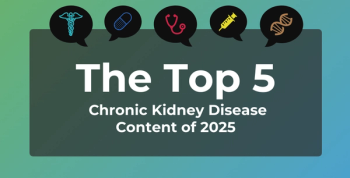
Clinical and Humanistic Burden of IgA Nephropathy
Robert Toto, MD, provides his expert opinion regarding recent data from Forsythe, et al about the clinical and humanistic burden of IgA nephropathy.
Episodes in this series

Robert Toto, MD: There’s a study that was done to look at the burden of illness in patients with IgA nephropathy. This was an interesting and well-done study. What the authors of the study were trying to do was to estimate the burden of disease in patients who have IgA nephropathy. They did this by a systematic literature review, and they also did a review of epidemiological studies in patients with IgA nephropathy. That methodology was a literature review where they called out papers that could address this. What they were looking at included the patient populations, interventions, outcome measures, and various study designs that made up part of their systematic literature review. For example, the outcomes they were trying to evaluate included quality of life, patient-reported outcomes, symptom burden, and costs both direct and indirect.
The study designs included real-world evidence studies, prospective observational studies, registries, database analyses, and retrospective studies as well. There was a whole panoply of different studies they looked at in their review. For the systemic literature review, they started out with over 1500 records, and after excluding all of the studies that were missing data, they came down to 11 records from the 1500. From the epidemiological side, they started with about 5500 and distilled that down to about 123 records that they were able to evaluate.
From my perspective, the key thing they found in this study was that there was a significant burden of illness, but there’s heterogeneity of what’s reported in the study. That made it a little complicated to evaluate, but they found increased symptom burden including fatigue as an important feature in patients who have IgA nephropathy. They also identified disturbances of the mental health of these patients, based on the need for counseling for anxiety and depression among the patients, because of fear of future kidney failure. When they looked at progression to end-stage kidney disease, they found quite a bit of heterogeneity in the rates of transition to end-stage kidney disease. Part of this is due to the fact that the analyses were all based on retrospective data, either registries or single-center studies.
What they found was that up to 50% of patients with IgA nephropathy will progress to end-stage kidney disease. They found also that the longer the follow-up time in the study that they were evaluating, the higher the rate of end-stage renal disease, which is not too surprising. If you follow the patients long enough you may find increased cases of end-stage kidney failure, and that’s what they did. For example, in the poster they present one of their retrospective single-center studies, which was the largest of the studies that they examined and included 251 patients, and 53% of those patients progressed to kidney failure. However, they had a follow-up time of 19.3 years. That’s about 5 times longer than any of the other studies that they were able to analyze.
They also looked at mortality in patients with IgA nephropathy, and again they found a considerable amount of heterogeneity among the studies in terms of all-cause mortality. The mortality rates in IgA nephropathy vary a lot, and they worsen if somebody develops end-stage kidney disease, and that’s related to the fact that patients on dialysis have much higher comorbidities and mortality rates than those who are not on dialysis. I think what this poster also points out is the need for more studies because they conclude that IgA nephropathy is a relatively rare disease. On the other hand, I brought in the potential caveat that maybe it’s just underdiagnosed and under-recognized, so the incidence rate may be higher. I think this literature review tells us that we need better data. When we have these single-center studies that are retrospective and last from 3 years up to 19 years, it tells me that we haven’t really studied this systematically. This is a systematic literature review, yes, but that’s different from a systematic study of the population of people who have IgA nephropathy. These studies are mixed, and that’s one of the major limitations of these. The authors point out that the variable rates of renal biopsy likely led to differences in diagnostic pathways, and the interpretation of the literature in different countries becomes confounded because of that.
Their conclusion, which I think is a correct one, is that there are opportunities for additional research to expand the body of literature on IgA nephropathy, particularly in epidemiology, and humanistic and economic burden, in terms of the US-specific data as well. My interpretation with this poster is that we need better registries and better databases, and we need a more rigorous approach to biopsying patients who look like they’re at risk for IgA nephropathy for us to get a better picture of the incidence severity and the rate of progression of IgA nephropathy to kidney failure.
Transcript edited for clarity.
Newsletter
Stay ahead of policy, cost, and value—subscribe to AJMC for expert insights at the intersection of clinical care and health economics.






























































